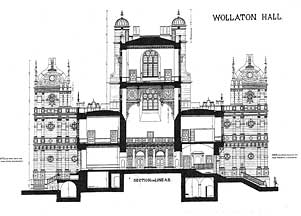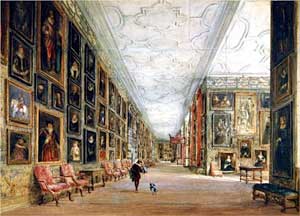Events and excursions, Winter 2019-20
The Archaeology Lecture, 12th October
‘Nottingham Castle Development and Archaeology' by Sara Blair-Manning, Chief Executive, Nottingham Castle Trust
The Society was pleased to welcome Sara Blair-Manning, recently appointed as Chief Executive Officer of the Nottingham Castle Trust, to deliver the annual Archaeology lecture. Sara discussed the on-going Nottingham Castle Project, outlining its objectives and providing valuable insights into the new galleries and other facilities that would be provided for visitors to the Castle and its grounds.
Sara commenced her presentation with a review of the more significant discoveries that had been made during recent archaeological investigations and continued with a comprehensive review of the proposed new galleries and other visitor facilities. These include a new Visitor Centre inside the main entrance gateway, including interpretation facilities, shop and café; a Robin Hood gallery including a themed play area for children with story-telling and other activities; a Rebellion gallery including displays focusing upon the Civil War, Luddites, Chartists and the Reform Bill riots; a gallery containing a thematically organised selection of the museum’s paintings; a series of cave experiences; and an exhibition focusing upon the lives of those who worked and resided in Brewhouse Yard. She also outlined the proposals for daily programmes of learning activities for schools and other groups and for temporary exhibitions focusing upon rebellion and other themes associated closely with the Castle. Sara concluded her lecture with an evocative flythrough of the castle around 1485. This showed clearly its relationship to the contemporary landscape and provided striking visual images of the castle defences and its rich variety of internal buildings.
The talk generated considerable interest from the audience, prompting many questions on the displays and other facilities planned for the site, and provided a valuable introduction to future presentations to the Society on archaeological work at the Castle. These will commence with a presentation by Gareth Davies of Trent & Peak Archaeology on the important archaeological discoveries that were made during construction of the Visitor Centre, in the Ducal Palace’s sunken courtyard and at other locations around the Castle grounds.
David Knight
The Neville Hoskins Lecture
'Stanley Middleton, Nottinghamshire Author' by David Belbin, Chair of Nottingham UNESCO City of Literature
The society welcomed David Belbin to give the Neville Hoskins lecture in December. He started by saying that he was speaking as an admirer and friend of Stanley Middleton as well as a fellow novelist. He began with a resume of Stanley’s early life as the youngest of three children, born in Bulwell and eventually passing the scholarship to High Pavement Grammar School. He attended the Methodist Sunday School where he remembered the Minister’s interest in the complexities of the English language and the high standard of musical concerts.
From High Pavement Stanley went to Nottingham University where he was awarded several scholarships and exhibitions, reading English with French as a subsidiary subject. At the end of his second year, he took his degree before joining the army. After the War in 1945 he became a teacher and taught English at his old school. Following getting married his writing career took off. He started writing at the dining room table in their home in Broomhill Road, Bulwell. After getting advice from the poet and novelist Cecil Day Lewis, his approach to writing changed to, as he said, ‘just making it up as I went along’. When his first novel was published Stanley became Head of English at High Pavement Grammar School and he remained in that role until his retirement. He encouraged many boys to love literature and Shakespeare in particular. His pupils included the playwright Peter Mortimer and actors John Bird and Peter Bowles. In 1960 he published the novel ‘Harris’s Requiem’ about a music teacher with aspirations to become a classical composer. Many found this book uncomfortable reading. Stanley Middleton’s forte was in writing about richly complex characters, who cannot easily be described as stereotyped. Characters interested him much more than a plot to his books. He also in his books captured the notoriously difficult Nottingham dialect and the city’s brittle and cynical humour. In 1974 he received the news that one novel ‘Holiday’ was to be short listed for the Booker Prize and with the support of A.S. Byatt he was awarded the prize. During his life Stanley Middleton wrote over 40 novels. Shortly before his death he completed ‘A Cautious Approach’, which to the last depicts his bold experimentation with flash backs and embedding of one scene or dialogue with another.
The lecture ended with a number of slides including a picture of the plaque erected on the front of 42 Caledon Road, on the day of Stanley Middleton’s Centenary. The plaque was erected with support from the Nottingham University and the Civic Society. As David Belbin concluded, the plaque was a fitting memorial to a great writer.
Penny Messenger
Stanley Middleton Books recommended by the Editor: ‘Holiday’ (1974); ‘Harris’s Requiem’ (1960); ‘Entry into Jerusalem’ (1983); ‘Valley of Decision’ (1985)
Maurice Barley Lecture, January 2020
'Wollaton Hall and New Hardwick Hall through 400 years' by Pete Smith
This first lecture of the 2020 season attracted a full house of members and friends to hear Pete Smith’s lecture. He is a long-time member of the Society’s Council, and a past organiser of some of the Society’s visits to historical places, especially those in the care of English Heritage, where he was the Senior Architectural Investigator before he retired. He is also the co-author with Rosalys Coope of their recent highly praised volume on Newstead Abbey.
Pete now works as an Independent Architectural Historian. His interest in historic places, and expert knowledge about them, became very apparent in this lecture about the two great architectural masterpieces of Robert Smythson locally, Hardwick Hall and Wollaton Hall. Pete’s lecture was well-furnished with slides of the plans of the buildings, which are famous for their symmetry and the amount of glass in their construction. We saw images produced by artists and topographical illustrations of both Halls at different times of their history, together with quotations by various people who, over the years, have expressed views and opinions about both Halls. Pete’s meticulous knowledge about individual aspects of the architecture of the Halls indicated interesting areas of similarity and difference between the two buildings. Pete also made observations about the influence which Smythson’s work on both Halls has had on the design of later country houses.
The lecture produced several questions from members of the audience. It was a most enjoyable afternoon, in which the enthusiasm and personal enjoyment of Pete’s work shone through.
 |
 |
|
| Wollaton Hall | New Hardwick |
Alan Langton